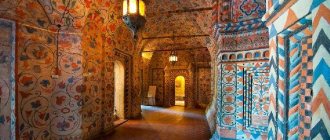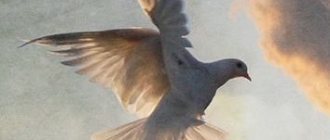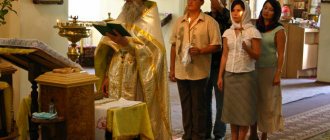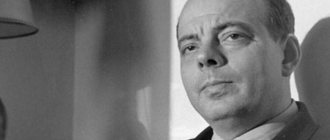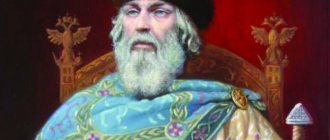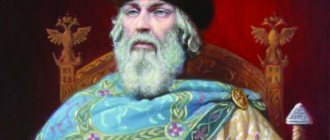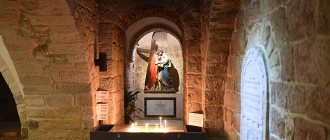An Orthodox church is a place where believers come to pray, confess their sins, listen to the priest’s sermons, light candles, write notes, venerate icons, and order prayer services.
But the temple is not only prayers and notes. After all, this is the place where you can enjoy real art. Yes, yes, art. Not many people know that religion and art are very connected.
Religion and art are closely related to each other.
Over the course of many centuries, art and the Orthodox faith intertwined and flowed into each other, as a result of which Orthodox art arose. Let's talk about what types of arts are found in Orthodoxy.
Image Features
The most important canon in painting icons was the elevation of the sacred image above everything earthly. For this reason, in this type of church art there was a lot of staticity, a golden background that emphasized the conventionality of the plot. The entire set of artistic means was aimed precisely at creating such an effect.
Even images of objects were given not as a person would see them, but as a divine essence would see them. Since it was believed that it was not concentrated at a certain point, but hovered everywhere, objects were depicted in several projections. Also in church art, time is depicted in accordance with the same canons - from the position of eternity.
The icon will be transformed
— What, in your opinion, is the future of icons as art? “If people create and work, then there will be a future.” And the icon will be transformed. Perhaps there will be some kind of symbiosis, a mixture of styles, for example, the Palaeologian and Comnenian periods. Or vice versa - something new will be introduced into these styles. Wait and see. —Are icons and avant-garde compatible? — Artists once offered me to paint an icon in the grotesque, but I didn’t sign up for it. I instinctively understand that this is alien, and I don’t want to participate in it. I still haven't learned what the art teachers left me. I still open old albums, look at them, feel moved, and always find something new. — Alexander, why did you choose the Paleologian style? - It has no end...
Development of Christian art
It is important to consider that before the advent of modern church art, it had gone through more than one stage. Their change is due to different stages in the cultural development of society. The formation of ancient Russian church art took place under Byzantine influence. Its development begins from the moment when Vladimir brought Christianity to Rus'. In culture, this was, in fact, a transplant operation, because until that moment there were no such traditions in the country. He was removed from another society and transplanted into the body of Rus'. The church art of Ancient Rus' began to develop from the borrowing of already existing well-thought-out monuments, religious buildings and rich ideas.
For this reason, Christianity had several advantages over paganism. Compared to the majestic temples of Russian ecclesiastical art, ancient monuments with altars were inferior in aesthetic terms. In the latter there was a dominance of flies, which always accompanied the making of sacrifices. In the new temples, the domes glittered golden in the sun, the colors of the paintings, religious clothing, and music played, amazed people who were not used to this.
Church singing has always been the favorite art of Rus', and even now
The Orthodox Church is focused specifically on the human voice. Church music is filled with high spiritual beauty.
There is something incomprehensible in it, as many say, that encourages us to think about the most important, most eternal questions - life and death, the meaning of human existence on this earth.
The singers stand on the choir performing various prayers. Previously, melodies and chants were very simple. Now a lot of notes of various chants have been created.
That is why now in churches only specialists who know musical notation stand on the choirs. There are also special books for chants.
In the temple, only specialists who know musical notation stand on the choirs.
The chants are also divided into vocal and non-vocal. Non-vocal musical works were written by church composers. The vocal chants retained some similarity with the ancient modes.
In addition to singing, the service also includes reading. The sacred texts of Scripture and prayers are read. Reading in the temple alternates with singing.
Notes of the troparion for the feast of the Nativity of Christ, tone 4
An example of church singing at Christmas.
Performed by the choir of the Pafnuti Monastery, consisting of only 4 men. Troparion.
Monumental historicism
It was these ideas that were fully reflected in the style of church art of Rus' - monumental historicism. It became widespread in the X-XIII centuries. The experience of Byzantium was transferred to the worldview of barbarian society.
It is noteworthy that in the general European Romanesque style, in the mainstream of which Russian church art developed before the Mongol-Tatar yoke, personality was also poorly expressed. Every building of that era reflects a folk creation through the prism of Christian ideas. Man sought to feel himself as a cultural element, to achieve a sense of integrity.
When Yaroslav the Wise came to power, the largest Russian cities acquired their own St. Sophia cathedrals. They were erected in Kyiv, Novgorod, Polotsk. Russian masters were trained by Greek craftsmen.
In the era of feudal fragmentation of the 12th-15th centuries, the local nobility chose national forms. Then, in the visual, architectural, church and singing arts, the features characteristic of a particular locality become more and more evident. The formerly united state fell apart, and each of its islands had its own. This was reflected in art, which has now become diverse.
In the painting of Vladimir and Novgorod, the traditions of Byzantium are manifested - the aristocracy of lines, images and shades. Craftsmen from Greece were often invited to work. The architecture was influenced by Romanesque traditions. Sometimes German masters left their mark here. In addition, a number of the most famous monuments that have survived to this day - the Assumption and Demetrius Cathedrals - reflected the influence of the pagans. Sacred birds and a tree appear here; the image of a person does not dominate. This is a reflection of the human mentality of that era.
But in Novgorod and Pskov, in the struggle between princes and boyars, the latter win, unlike other Russian cities of that era. And here the churches differ significantly from those in Vladimir. Here the temples are squat, their colors are bright. Animals and people are buried in the ornaments that folk craftsmen loved so much.
Many icon painters do not speak the language of iconography, and this is sad.
It is very important for an icon painter to study the language of iconography. As a rule, masters try to copy everything without understanding the language of iconography itself. And this is akin to drawing a skeleton in an anatomy lesson. If you don’t understand the anatomy itself, you won’t be able to create a route drawing. Without understanding the structure of the skeleton, how ligaments and muscles are attached, you cannot draw - you can only copy. This is exactly how icon painters, as a rule, copy - they took the legs here, copied the arms there, and copied the face there. I also practice this sometimes, I won’t hide it. But it immediately becomes clear where the face was taken from. Many icon painters do not speak the language of iconography, and this is sad. Of course, human life is not enough to study everything. Today, a huge database has been provided, all samples are in the public domain. So they begin to rush at everything, indiscriminately, because there is not enough knowledge. It’s good if an icon painter can “go through” all periods and get a good result, if he can bring something from each school of painting into his work, but more often it’s the other way around. But if an icon painter is proficient in miniature painting, he has developed feeling, tact and taste, then he can introduce his own nuances, some subtleties into Byzantine iconography - and there will be harmony. It's very cool when an icon painter wields a brush. You should always take a pencil and make sketches. I practice this very often. Before making an inscription, I write without markings, as if I were making this inscription with a brush. I kind of repeat it. It's very convenient and useful. For example, if you saw some kind of fresco in an album, noticed the beautiful direction of the eyebrows, the position of the eyes, you saw the character - take a pencil and make a sketch, try to let everything pass through yourself. This is how experience accumulates. Otherwise, it’s difficult to run from one period to another: you won’t understand anything there, and this period remains unclear. For example, nearby there are frescoes and mosaics of the Chora Monastery and icons of the Stroganov school of writing. I like it, and I like it. There are people who say about the Stroganov school of icon painting that it is a decline, that there is too much attention to appearance and puppetry. But it is absolutely impossible to put these samples side by side and compare them. Anyone who does not respond and does not pay attention to different periods is depriving himself of a lot. The main thing is to deprive yourself of the joy of knowledge.
Mongol-Tatar yoke
Having passed through Rus' with fire and sword, the Mongol-Tatar tribes destroyed many examples of art of those times. Entire cities with their majestic buildings and craftsmen were destroyed. Vast territories once inhabited by the Slavs lay empty, while Poland, Lithuania and the Livonian Order captured Western Russian lands.
Culture glimmered in Novgorod and the Vladimir-Suzdal principality. But here art experienced a real decline. And only in the 14th century did its rise begin, which was called the Pre-Renaissance.
This was a specific socio-cultural state of society, which was reflected in all types of art. At this time, ideas about individuality and personality arose in the mentality of people, and creators began to search for something new. In Rus' it began to develop under the influence of Byzantium.
The traditions of Novgorod art were attacked by Theophanes the Greek. His energetic brushstrokes, spaces and expression had a massive influence on the art of his times.
At the same time, a national genius of painting appeared - Andrei Rublev. His works reflect humanistic ideas and soft lines. They are considered the true masterpieces of all time. He combined the divine essence and human traits in the same images.
“Temple synthesis of arts. Lesson 2"
TEMPLE SYNTHESIS OF ARTS
LESSON 2
TEST
- 1.What is a synthesis of arts?
- A) combining art forms into an artistic whole
- B) contrast between arts
- C) comparison of arts
- 2. What is a temple?
- A) the dwelling of a worldly person
- B) religious building
- B) secular building
- 3. What types of art are found in Orthodoxy?
- ______________________________________________
- 4.What feelings does religious art awaken?
- ______________________________________________
The melodiousness of the Word
Severe faces of ancient icons
Majestic architecture of churches and temples
The melodiousness of the Word, the strict faces of ancient icons, the majestic architecture of churches and temples, the monumentality of frescoes, the restrained plasticity of sculptures, the sound of church music with its strict and sublime melodies, objects of decorative and applied art - all this evokes high moral feelings, thoughts about life and death, sin and repentance, gives rise to the desire for truth and ideal. Religious art appeals to such human feelings as compassion and empathy, tenderness and peace, enlightened joy and spirituality.
- The temple is an image of the presence of the Kingdom of Heaven on earth, and, accordingly, it is an image of the palace of the King of Heaven . From this image comes the tradition of decorating a temple like royal palaces using all the artistic means available to a particular era.
Today we will look at churches of the main faiths - an Orthodox church, a Catholic cathedral, a Muslim mosque and a Buddhist temple.
Construction of an Orthodox church
.
The Orthodox church comes from Byzantium.
According to religious beliefs, the church building personifies the cosmos, where domes and vaults symbolize the sky, and walls and pillars symbolize the earth.
The temple was always placed with the altar to the east - towards the sun - not by chance: God is associated with light.
Every temple is crowned
a dome and a cross.
The dome symbolizes the sky, so it was often painted blue and covered with images of stars.
The number of domes was given symbolic meaning. Two were interpreted as a manifestation of the divine and human principles in Christ, three - as three hypostases, that is, essences, of God (Father, Son and Holy Spirit), five - as Christ and the four evangelists, thirteen - as Christ and the twelve apostles.
The dome rests on a cylindrical drum
, cut through by windows.
The domed drums and vaults are supported by arches on powerful pillars. On the outside, the walls are completed with semicircular zakomaras
, repeating the outlines of the vaults. This name comes from the ancient word “komara”, which means vault.
The eastern part of the temple has semi-cylindrical projections - apses
,
in which the altar is located. From the outside, the eastern part of the temple is easily recognizable by the apses - semi-cylindrical projections that house the altar. Their number (one, three, five) most often depends on the size of the temple. Domes with crosses and apses are perhaps the most characteristic details of the temple, distinguishing it from any other building.
The artistically decorated entrance to the temple is called a portal
, and the open porch in front of it is
a porch
.
Sometimes temples were surrounded by open or closed galleries
, which in Russia were called gulbischami - from the word “to walk”.
Often chapels
- small temples with their own altar with a throne and a dome with a cross. The presence of one or more chapels in the church made it possible to perform several services during the day.
Temple interior
.
Let's take a look inside the temple. The narthex
a vestibule attached to it on the western side
, separated by a blank wall with a door. In the narthex during the service there were those who were forbidden to enter the temple for sins, as well as those who were just preparing to be baptized.
Choirs
From the vestibule, a door leads to the middle, most spacious part of the temple, where the believers were located during services. Choirs were often held here above the western entrance.
- kind of like a balcony. There, separately from ordinary parishioners, the prince prayed with his family and entourage.
In the eastern part of the temple there is a sanctuary - an altar
.
It is separated by a barrier lined with icons - an iconostasis .
In the depths of the altar is the main accessory of the temple - the throne, which is a stone table symbolizing the “Holy Sepulcher”. In an Orthodox church, the main room of the church, including the under-dome space, is reserved for worshipers. The altar part is for divine super-reality.
In the southern part of the altar there is a special room - the deacon.
.
In it, before the start of the service, the priest and his assistant, the deacon, put on sacred vestments - vestments. This is where vestments are usually stored, hence the second name for the deacon - sacristy
.
In the northern part of the altar there is another room - the altar
, after the name of the stone table standing in the middle of it. During the main Orthodox service - the liturgy - holy gifts - bread and wine - are prepared for communion.
An icon is a visible reminder of God and a call to Him.
In ancient times, strict monophonic melodies were in tune with the faces of saints represented on icons, mosaics, and frescoes. In the 18th century they were replaced by polyphonic concert compositions, symbolizing the power and unity of secular and ecclesiastical principles as the basis of Russian statehood.
The golden background seems to carry the figures of saints into inaccessible luminous spheres. Intense colorful spots in mosaics give expressiveness to the images of saints and real people. The shining of a huge number of lamps and candles, the singing of skillful and trained singers enhance the splendor of the service.
Architecture, sculpture, painting, the sacrament of liturgical action in an Orthodox church are correlated with unaccompanied choral singing (acapella).
Catholic Church
Catholic churches, of course, are very different. The layout of most of them is based on the idea of a Roman basilica. By the 12th century. this layout became more complex and acquired the following structure.
The temple has always been oriented towards the cardinal points.
The portal (entrance) was always oriented to the west. In front of the portal there was a courtyard, sometimes fenced with galleries.
The Gothic cathedral, with all the richness of its constituent elements, amazes with the extraordinary unity of both the architectural plan and the entire decorative system (exterior and interior). Moreover, this unity characterizes the Gothic style as a whole.
The grandeur and majesty of the architectural image of the Catholic cathedral sounds especially sublime in the bright, soaring interior
. All decorative elements rush upward in a powerful stream: thin, graceful pillars, columns, pointed arches. Huge openwork windows with colored glass - stained glass - create a transparent and light barrier between the interior of the cathedral and the outside world. The colored mysterious light pouring through the stained glass windows, creating an unusual color environment in the temple, different from the outside world, symbolizes the light of Christian knowledge.
We hardly see icons in a Catholic church, but the portals and altar barriers of Gothic cathedrals are entirely decorated with statues, sculptural compositions, ornaments, and fantastic figures of animals
(chimeras).
Primary importance was attached to the decor of the main - western - portal of the cathedral. A special iconography was developed for him, the purpose of which was to present the Christian concept of the world.
The clearest example is the western portal of Amiens Cathedral with its famous “Blessing Christ” on the column of the pier, sung by many generations as “The Beautiful God” (Le Beau Dieu).
Huge openwork windows with colored glass - stained glass
— make a transparent and light barrier between the interior of the cathedral and the outside world. The colored mysterious light pouring through the stained glass windows, creating an unusual color environment in the temple, different from the outside world, symbolizes the light of Christian knowledge.
In the development of stained glass
, as well as in the detailed elaboration of the iconography of the portals and the entire sculptural decor, there is nothing accidental. We can see a well-thought-out system of characters and scenes not only inside one window or rosette, but throughout the entire system of stained glass windows of the cathedral as a whole. And here we see the same comprehensiveness that has already been discussed in connection with the concept of the Gothic cathedral as a whole.
This place was called the atrium (or narthex).
A porch led from the narthex to the portal - an elevated place. In the narthex and on the porch there were usually those excommunicated and catechumens, i.e. those preparing for the rite of baptism (they were not allowed to enter the temple during the service. The main portal and side portals led to the main and side naves of the temple.
The plan of the Catholic church of the Middle Ages was based on a Latin elongated cross. The elongated part of the temple is designed not only to accommodate a large number of believers, but also to be a symbol of the long path along which a person must travel in his perfection. It is not for nothing that scenes of the so-called Stations of the Cross - an image of the suffering of Christ - were often placed on the side walls.
Nave (French nef, from Latin navis - ship) is an elongated room, part of the interior (usually in basilica-type buildings), limited on one or both longitudinal sides by a number of columns or pillars separating it from neighboring naves.
The main nave was intersected by a transverse nave running from south to north. The intersection of the main and transverse nave is called the middle cross. Usually this place is indicated by a spire or dome (similar to the dome in Orthodox churches). Behind the middle cross there is usually a choir - a place for the clergy present during the service. This part symbolizes the image of heaven.
The main semantic elements of the temple and its most sacred places are located in the presbytery - the altar and tabernacle - tabernacle (from the Latin Taberna`culum - tent), i.e. The Holy of Holies, where the Ark of the Covenant was located during the expedition from Egypt. The altar corresponds to the altar of an Orthodox church. This is a table covered with a blanket, on which there are liturgical utensils and liturgical books. It is always open and all believers see the sacraments of communion. The main sacred rites are performed at the altar.
An important element of large Catholic churches has always been the pulpit from which the priest delivered his sermon. If a bishop constantly conducted services in a temple, the temple was called a cathedral (a cathedral is a church in which the chair of a bishop is located - the head of the church in a certain territory - a “diocese”).
In every Catholic church there is always a place for confession, which is called a confessional or confessional.
Under the choir, below the floor level, there is a crypt (“secret place”), a crypt where the burial of the saint to whom the temple is dedicated is located.
Catholicism and Orthodoxy - Main differences in dogma
- Orthodoxy does not accept the Latin formulation of the Nicene-Constantinopolitan Creed with the filioque, which speaks of the procession of the Holy Spirit not only from the Father, but also from the Son (Filioque).
- Orthodoxy rejects the dogma of the infallibility (inerrancy) of the Pope and his supremacy over all Christians.
- In Catholicism, unlike Orthodoxy, there is a dogma about the immaculate conception of the Virgin Mary, as well as Her bodily ascension.
- In Catholicism, in contrast to Orthodoxy, there is a dogmatic concept of purgatory, as well as a doctrine of the supererogatory merits of saints.
Mosque
A mosque is not a temple where sacraments are performed during worship, but a place for collective prayer, indicating the qibla to believers, that is, the direction to the Kaaba - the main shrine of the Muslim world, a cubic structure in the courtyard of the Forbidden Mosque in Mecca, where the “Black Stone” is kept.
Inside the mosque, if there is no prayer, men, women and children can walk anywhere: there are no “sacred places” or “protected areas”.
The Muslim temple (mosque) with its great dome symbolizes the one God (Allah) and the minaret (tower near the mosque) - his prophet (Mohammed).
The main architectural elements of the mosque served as the basis for the formation of Muslim concepts of beauty. The huge dome hovering above the mosque, as well as the architectural “stalactites” - niches hanging over each other, create the illusion of an endless and incomprehensible sky and symbolize divine perfect beauty, and the minaret - divine greatness. Decorative sayings from the Koran are placed on the walls of the mosque.
The Muslim mosque includes two proportionate spaces - an open courtyard and a shaded prayer hall.
The part of the mosque, which is directed towards the holy Mecca for Muslims, has a mihrab (empty recess) in its design. To the right of which there is a minbar (a special pulpit from which the preacher, imam, reads a prayer to believers during Friday prayers).
The minarets are decorated with belts of patterned brickwork or stone carvings, openwork grilles and balconies, ornaments and inscriptions. The minaret ends with a dome or tent. The walls are thick, but their heaviness is not visible. Why? The effect of ceramic mosaics, paintings, carvings. All this, like a flowery carpet, covers the buildings, making you forget about the massiveness of the structures. The heaviness of the walls, which is not felt behind the cladding, azure patterned tiles.
Everything is in a simple form, but the surface is completely covered with complex patterns. Leaves, flowers, rhombuses, stars, inscriptions. These patterns are intertwined. It's hard to take your eyes off them. The walls are lined with tiles and ceramic tiles covered with mosaics.
In the religious culture of Islam, among all types of arts, architecture (palaces, mosques) and poetry, sounding to the accompaniment of string instruments, received priority. The depiction of a deity or any living creature was considered sacrilege. Therefore, the artistic style of Islam is decorative, ornamental.
The ornament, endless in nature, serves as a way of artistic expression of the Islamic worldview. It is the ornament that is built on the rhythmic repetition of the main motifs. And in Islam, repetition is considered one of the reliable ways to comprehend the truth and express devotion to Allah.
Buddhist temple
The ancient Buddhist temple, built of powerful hewn stones and slabs, was the basis for a lush and heavy ornamental sculptural decoration covering almost its entire surface. A peculiar consequence of this is the absence of an arch and vault.
The pagoda is of particular importance in temple ensembles of Buddhist culture. The spire that ends the Buddhist pagoda is usually located on the central column, under which jewelry was kept. This treasure symbolized the ashes of Buddha. The pagoda is designed to store the remains of the earthly body of Buddha Shakyamuni. Almost every temple has a legend about how these remains got to Japan: they were miraculously transported to the islands or they were sent as a gift by the rulers of the mainland powers. The pagoda has three or five tiers; in the center there is always a main pillar made from the single trunk of a large tree. The remains of the Buddha are kept either along the central pillar or on its top
Buddhist temples are distinguished by the special design of their cornices: they bend so softly and gracefully that they take on the appearance of an almost horizontal arrangement. The roofs are characterized by a hip-and-gable style. The height of the buildings was small, since the harmony with the surrounding nature should not be disturbed. The decor of Buddhist temples is dominated by yellow and red colors.
The magical guards of Buddhist temples, frozen in stone, look very original. In the corners of the roof, stone mythical monsters grin, symbolizing the evil forces that are kept at a distance from the temples.
Thus, a Buddhist temple is not a separate building, but a whole system of special religious buildings, thereby reminiscent in its structure of ancient Russian monasteries. Their structure depended on their purpose: they could be part of a complex of educational buildings - for example, a school.
The place of construction also mattered - Buddhist temples are always very harmoniously integrated into the natural landscape, often next to waterfalls and rivers.
In Buddhist temples, numerous bells hang on the roofs. They sway at the slightest gust of wind, filling the surrounding space with a gentle melodic ringing. At the same time, bells protected the sanctuary from the penetration of evil spirits and were part of ritual objects that were used in church ceremonies. Buddhist religious holidays are usually accompanied by processions with theatrical performances, music and ritual dances in the open air.
- To be a Buddhist means to “take refuge in the Three Treasures”—the Buddha, his teachings, and his community. Typically, a Buddhist temple is designed in such a way that all the “Three Treasures” are collected and clearly presented in one place. This place must be protected from the outside world, from extraneous sights, sounds, smells and other influences. The territory of the temple is closed on all sides; powerful gates lead to it.
- In Russian translations of Japanese texts and in the works of researchers you can often find the phrase “Buddhist monastery”. It is important to keep in mind that “temple” and “monastery” in this case are the same thing. Monks live in any temple.
- Sculpted, painted or embroidered images of the Buddha are placed in the “golden hall” - the condo. There may also be images of bodhisattvas and other revered beings.
- The teaching resides in the temple in the form of texts from the Buddhist canon. They are not simply kept in the form of scrolls of books or in the memory of experts, but are constantly reproduced through reading and interpretation in the “reading hall”. The community consists of monks, their disciples, as well as lay people who temporarily settled in the living quarters of the temple. As a rule, these rooms are arranged in galleries.
THANK YOU FOR THE LESSON
The period of Moscow's rise
In the last third of the 15th century, events occurred that marked the beginning of a new stage in the development of Russian culture. Moscow, having subjugated its rival Novgorod, became the center of the Russian principalities. The long era of monarchy began. Centralization affected both the worldview and the development of Orthodox church art.
The beginning of the Pre-Renaissance resulted in the Renaissance in Rus', being crushed by the reign of Ivan the Terrible. Everyone related to the reform processes was defeated. Many leaders were executed, exiled, and tortured. In the struggle between the non-possessors, who opposed church property, and the Josephites, who followed Joseph Volotsky, who advocated the union of the state and the church, the latter are victorious.
Freedom in a monarchical state is becoming less and less. Its adherents - boyars, princes - die in mass executions. The enslavement of the peasantry occurs, civil liberties disappear, and nobles appear who were the tsar's loyal servants. Then the “master and slaves” model arises in Russian history. Individuality falls into the shackles of the state.
In temples
The processes of this period were fully reflected in church art. Temples began to express the ideas of centralization; they are strict and emphasize the new state style. The culture of those years symbolizes the victory of Moscow. This is clearly visible in the exhibits of the Patriarchal Museum of Church Art. All local architectural features disappear, and everywhere there is a reference to the Assumption Cathedral in Moscow.
However, tented churches also appear. They are distinguished by their great height, rich decoration, and lighting. They almost completely lack interior paintings.
New time
With the beginning of the 17th century comes the New Age, when traditional society undergoes major changes. This happens due to the events of the Time of Troubles and numerous military actions. The monarchy becomes absolute, the opposition boyars and the church find themselves subordinate to a strict vertical of power. With the Council Code of 1649, all classes of the country became enslaved.
And against this background, processes of human emancipation that are natural for the whole world are triggered. But in Rus' this happens under state oppression. Leaving the power of the church, the individual finds himself in the even harsher hands of the state. The presence of internal individualization, combined with complete lack of rights and lack of legal freedom, forms the characteristics of the mysterious Russian soul.
The culture is characterized by secularization, which is expressed in the mundaneness of motives, while the heavenly fades into the background. Russian people now even look at heaven with earthly eyes.
However, there is a trend towards democratization in church architecture. Religious buildings showed more external decoration and patterns. But construction is no longer carried out in the name of the divine, but for man. This explains the aesthetics of the buildings.
Church painting is also characterized by changes. Worldly subjects appear more and more often here. Artists try to paint as it happens in life. The history of the formation of Russian statehood is also reflected in painting.
Subsequently, the Russian Empire began to erect monuments symbolizing its power. This was manifested in the luxury of temples, which absorbed the features of secular architecture.
Throughout the 17th century, many changes were made to church life. Careful supervision is carried out over the creation of icons. During their writing, the canons are observed. The influence of pre-Petrine traditions has remained in the provinces for many years.
The peculiarities of Russian spiritual life of the 19th century were fully reflected by architectural mastery. For the most part, this can be seen in St. Petersburg. It was here that buildings were erected that eclipsed the beauty of the capital Moscow. The city grew very quickly, unlike the ancient capital. It had a single meaning - it should become a great European power.
In 1748 the famous Smolny Monastery was built. It was built in Baroque style. But many native Russian traits are embodied here. The monastery was built in a closed form. The cells were located in the shape of a cross around the cathedral. Temples with one dome were built at the corners of the composition. At the same time, symmetry was observed here, which was not typical for ancient Russian monasteries.
In Moscow of that era, baroque also dominated and classicism manifested itself. Thanks to this, the city also acquired European features. One of the most beautiful churches of that era is the Church of St. Clement on Pyatnitskaya Street.
The pinnacle of 18th-century architecture was the bell tower of the Trinity-Sergius Lavra. It was erected in Moscow in 1740-1770.
Church singing is also developing separately. In the 17th century it was significantly influenced by Western traditions. Until that moment, church music was represented by Polish-Kyiv singing. It was started in the capital of Rus' by Alexei Mikhailovich Quiet. It combined innovations and ancient motifs. But already in the middle of the century, musicians from Italy and Germany entered the St. Petersburg Chapel. Then they introduced the features of European singing art. Concert notes were clearly evident in church singing. And only monasteries and villages preserved ancient church singing. Some works from that era have survived to this day.
Architecture plays an important role in Orthodoxy
The architecture of the temple is canonical. It has an altar facing east, a main part and a vestibule. In the center of the altar there is a throne.
The throne in the altar on which is the Holy Gospel - which is read by the priest during the liturgy and the Cross
Three doors lead to the altar, one of which is central. It's called the Royal Doors.
This photo shows 2 doors on the sides and 3 doors in the center - the Royal Doors - the priest exits through it during the service
The elevation above the altar is the pulpit, from which the priest addresses the faithful. To the left and right are the choirs, where the singers are located.
There is a bell tower near the temple: the ringing of bells plays a very important role in worship and occurs depending on various occasions, for example, bell ringing, funeral ringing, holiday ringing.
A small bell tower near the temple. Many believers stop specially to listen to this wonderful sound of bells.
The temple also has a dome or domes, of which there may be three, five or more. The number of crosses also depends on the number of domes.
In ancient Russian architecture, the dome took on a peculiar “onion” or “helmet” shape. There is a cross at the top of the dome
About contemporary art
There is a point of view that contemporary Russian art is in decline. This was true until recently. At the moment, construction is developing very actively - a lot of churches are being built in the country.
However, connoisseurs of architecture note that in modern churches there is an incredible mixture of styles. Thus, icon painting under Vasnetsov is adjacent to pre-Petrine carvings and construction in the spirit of the Ostankino church.
Experts also express the opinion that modern architects are fixated on the external content of churches, no longer expressing the divine nature that they were originally intended to reflect.
At the moment, churches combine, for example, the domes of St. Basil's with the bell tower of the Nativity on Putinki. Copies are no better than originals. Often the task is put forward to simply repeat an already erected building, and this also does not contribute to the development of architectural thought in the country. There is a tendency that the architect follows the lead of clients who put forward demands in accordance with their vision of art. And the artist, seeing that the result is a pit of art instead of creativity, continues to implement the project anyway. Thus, modern architectural church art is going through hard times. Society does not contribute to its development in the future.
And experts in the relevant field note this trend, predicting its development in the future. But attempts to revive this area are being made on an ongoing basis. And it is possible that in the future this will bear tangible fruit, and there will be a kind of revival of church art in the country.
Orthodox jewelry has a strictly spiritual purpose
Nowadays, jewelers make truly beautiful things. These are crosses, icons in precious frames, church utensils and much more.
Specialized shops selling Christian clothing, jewelry, and various souvenirs also appeared. But many believe that the safest way to buy such things is only in the temple.
Jewelry Mother of God. You can always carry it with you
Gold pectoral cross with handmade diamonds
Orthodox jewelry is always made by hand. They are endowed with the priceless energy of their creator. They bear the imprint of his intention and spiritual content.
All work is done by craftsmen only by hand.
Gold Church Communion Supplies

